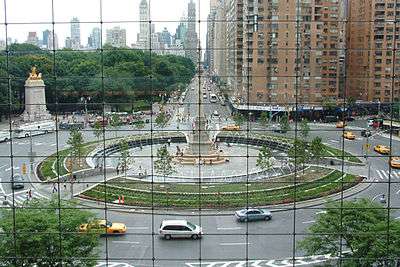Traffic circle

A traffic circle is a type of intersection that directs both turning and through traffic onto a one-way circular roadway, usually built for the purposes of traffic calming or aesthetics.[1] Contrary to a roundabout, where entering traffic always yields to traffic already in the circle and merges in directly, the entrances to traffic circles are three-way intersections either controlled by stop signs, traffic signals, or not formally controlled.[2] Colloquially, however, roundabouts are sometimes referred to as circles.[3]
In the United States, traffic engineers typically use the term rotary for large scale circular junctions between expressways or controlled-access highways. Rotaries typically feature high speeds inside the circle and on the approaches.[4]
In New England, traffic circles are generally called rotaries and the traffic that is already driving in the rotary always has the right of way (see roundabout). For examples of where this is specified, in Massachusetts "Any operator of a vehicle entering a rotary intersection shall yield the right-of-way to any vehicle already in the intersection.".[5] In Rhode Island entering vehicles "Yield to vehicles in the roundabout." [6]
Distinct from roundabouts, traffic circles and rotaries may also have an interior lane that requires traffic on it to change lanes in order to exit the circle.[7]

Design
Design criteria include:
- Right-of-way: Whether entering or circling vehicles have the right of way. The New Jersey Driver's Manual recommends that, in the absence of flow control signs, traffic yields based on "historically established traffic flow patterns",[8] and there are no set rules.[9] In New England,[10] Washington, D.C. and New York State,[11] entering traffic yields, as is the norm in virtually all countries outside of the U.S.
- Angle of entry: Angles range from glancing (tangential) that allow full-speed entry to 90 degree angles (perpendicular).[12]
- Traffic speed: High entry speeds (over 30 mph or 48 km/h) require circulating vehicles to yield, often stopping, which lowers capacity and increases crash rates compared to modern roundabouts.[13]
- Lane changes: Allowed or not
- Diameter: The greater the traffic, the larger the circle.[12]
- Island function: Parking, parks, fountains, etc.[12]

History
French architect Eugène Hénard was designing one-way circular intersections as early as 1877.[14] American architect William Phelps Eno favored small traffic circles. He designed New York City's famous Columbus Circle, which was built in 1905. Other circular intersections were subsequently built in the United States, though many were large diameter 'rotaries' that enabled high speed merge and weave maneuvers. These designs were doomed to failure for two primary reasons:
- It takes a large diameter circle to provide enough room for merging at speed. Although some of these circles were huge (many were in excess of 100 meters or 300 feet in diameter), they were not large enough for high-speed merging.
- Giving priority to entering traffic means that more vehicles can enter the circulatory roadway than it can handle. The result is congestion within the circle which could not clear without police intervention.
The experience with traffic circles and rotaries in the USA was almost entirely negative, characterized by high accident rates and congestion problems. By the mid 1950s, construction of traffic circles and rotaries had ceased entirely. The experience with traffic circles in other countries was not much better until the development of the modern roundabout in the United Kingdom during the 1960s.
Starting in the 1990s the USA saw a revival of mostly smaller traffic circles, termed "roundabouts".[15] The modern roundabout finally arrived in the United States in 1990 in Summerlin, a major Las Vegas residential subdivision.[15] As of December, 2015 there are about 4800 of these modern roundabouts in the United States. As an example, Washington State contains about 120 roundabouts as of October 2016, all having been built since 1997 with more planned.[16]
See also
References
- ↑ "Online TDM Encyclopedia - Traffic Calming".
- ↑ U.S. Department of Transportation: Roundabouts: an Informational Guide para 1.5
- ↑ Johnson, Jeffrey A. (6 August 2012). "Salem Four Corners traffic circle to start rounding into shape". The Day.
- ↑ U.S. Department of Transportation: Safety Aspects of Roundabouts presentation Archived 3 September 2014 at the Wayback Machine.
- ↑
- ↑
- ↑ U.S. Department of Transportation: Technical Summary: Roundabouts
- ↑ "Archived copy". Archived from the original on 13 August 2010. Retrieved 2010-02-21.
- ↑ http://www.state.nj.us/mvc/pdf/Licenses/Driver%20Manual/Chapter_4.pdf
- ↑ Commonwealth of Massachusetts, Registry of Motor Vehicles. "Sharing the Road: A User's Manual for Public Ways". Retrieved 2009-05-13.
- ↑
- 1 2 3 "Index - Roundabout: An Informational Guide, June 2000 - FHWA-RD-00-067".
- ↑ Shashi S. Nambisan, Venu Parimi (March 2007). "A Comparative Evaluation of the Safety Performance of Roundabouts and Traditional Intersection Controls". Institute of Transportation Engineers. Retrieved 2007-11-27.
- ↑ P. M. Wolf, Eugene Henard and the Beginning of Urbanism in Paris, 1900–1914, International Federation for Housing and Planning, The Hague, 1969, cited by Ben Hamilton-Baillie & Phil Jones, Improving traffic behaviour and safety through urban design, Proceedings of ICE – Civil Engineering, volume 158 Issue 5 May 2005 p. 41 "Archived copy" (PDF). Archived from the original (PDF) on 30 July 2007. Retrieved 2006-10-10.
- 1 2 History of the Modern Roundabout, RoundaboutsUSA http://www.roundaboutsusa.com/history.html
- ↑ Washintong's Roundabouts, WS-DOT website http://www.wsdot.wa.gov/safety/roundabouts/washingtons.htm
External links
-
 Media related to Traffic circles at Wikimedia Commons
Media related to Traffic circles at Wikimedia Commons
